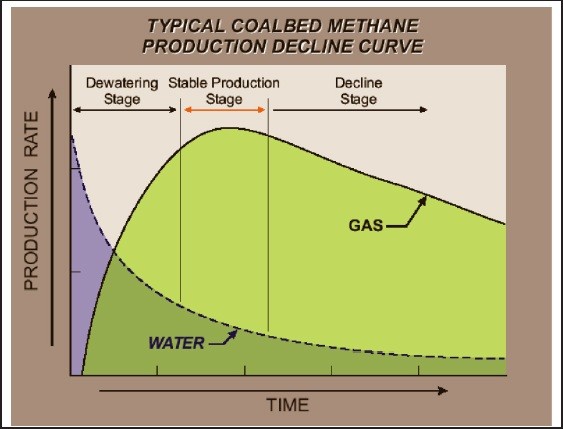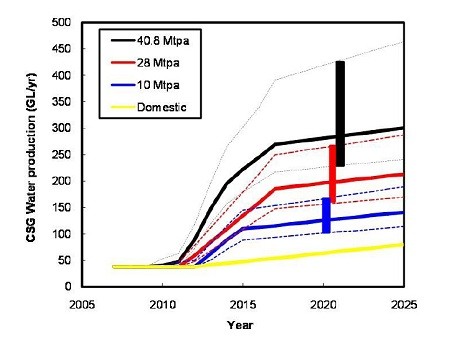Robert Merkel’s overview paper tells us:
Coal seam gas is extracted by drilling wells into an underground “seam” of coal, then pumping some of the water out, allowing the natural gas present in the seam to escape and be collected.
This process is called “dewatering” of the coal seam.
The amount of water produced can be made to seem a little or a lot, depending on your perspective. The Interim Report of the Senate Committee chaired by Bill Heffernan was told by the industry that water produced was as little as 0.0002% of the water contained in the Great Artesian Basin.
The ABC site Coal Seam Gas by the Numbers gives a range of estimates of the total water produced each year. For example, the National Water Commission estimates 300 gigalitres (GL), that’s 300 billion litres. By way of comparison, Sydney Harbour (or one sydharb) contains 500 GL.
What really matters, however, is the amount of water being extracted in the local area where the drilling takes place. That is where the extraction of water may have an impact on the aquifers which are used for farming, for industry and for human consumption and where the water produced has to be dealt with.
In this post I’ll try to build up an approximate concept of what the quantity of water might mean at the farm level.
The amount of water varies over the life of the well. This graph from a 2008 paper by Mal Helmuth shows the typical gas and water production profile for a CSG well:

So the amount of water produced varies considerably over the life of the well. It also varies from basin to basin and within that well by well. Helmuth calculated that within the Walloon tenement in the Surat Basin in 2007 the average well produced 36.4 ML of water each year. I make that about 100,000 litres per day.
To visualise how much this is, a cubic metre of water contains 1000 litres. So 100,000 litres is 100 square metres, one metre deep, so that’s 10 metres squared. We have a normal sized swimming pool in our backyard with an estimated capacity of 48,000 litres. It’s a kidney-shaped pool, 9 x 5m and possibly about 1.5m deep on average. So it’s about two of those each day.
Now take a look at this image and imagine the amount of water produced. A rough count indicates about 80 wells on that picture. According to Helmuth’s averages, there would be 160 of our swimming pools of water produced from what you see there every day.
In the Bandanna tenement, north of Roma to south-east of Emerald, the average well produced 177,000 litres per day in 2007.
For an overview of the bigger picture, Helmuth provides this graph of the projected water production in the Surat and Bowen Basins over the next two decades compared to domestic usage:

The three scenarios relate to how fast the field are going to be developed and how fast the gas in them will be extracted. The dotted lines indicate uncertainty in average well production.
The Queensland Government’s preferred option is either to provide cleaned up water to local landholders substituting for their water allocation or to inject it into a local potable aquifer. The ABC CSG site describes how water is being made available for beneficial use at Chinchilla. It should be noted that once farmers sign up they must take the water even if there is a flood, or incur a penalty.
Also, discharging into creeks and rivers as suggested on the ABC site is problematic because it creates unnatural flows and the demineralised water can damage stream ecologies.
Injection into aquifers is an industrial process illustrated here, where we are told that various studies are under way to further define the viability of different injection methods and locations. My understanding is that the water has to be injected in a very limited number of points. It is impractical to disperse it back to the areas from which it was drawn. We simply don’t know what the effects of this will be in the longer term.
Moreover there is still a problem of disposing of the masses of salt and other toxic residues.
When approval was given to companies to mine coal seam gas it was recognised that there was no satisfactory answer to the question of dealing with produced water and associated nasties. It is still a work in progress. Another case of learning by doing.
Brian Bahnisch
FAQ Research







Crikey is committed to hosting lively discussions. Help us keep the conversation useful, interesting and welcoming. We aim to publish comments quickly in the interest of promoting robust conversation, but we’re a small team and we deploy filters to protect against legal risk. Occasionally your comment may be held up while we review, but we’re working as fast as we can to keep the conversation rolling.
The Crikey comment section is members-only content. Please subscribe to leave a comment.
The Crikey comment section is members-only content. Please login to leave a comment.